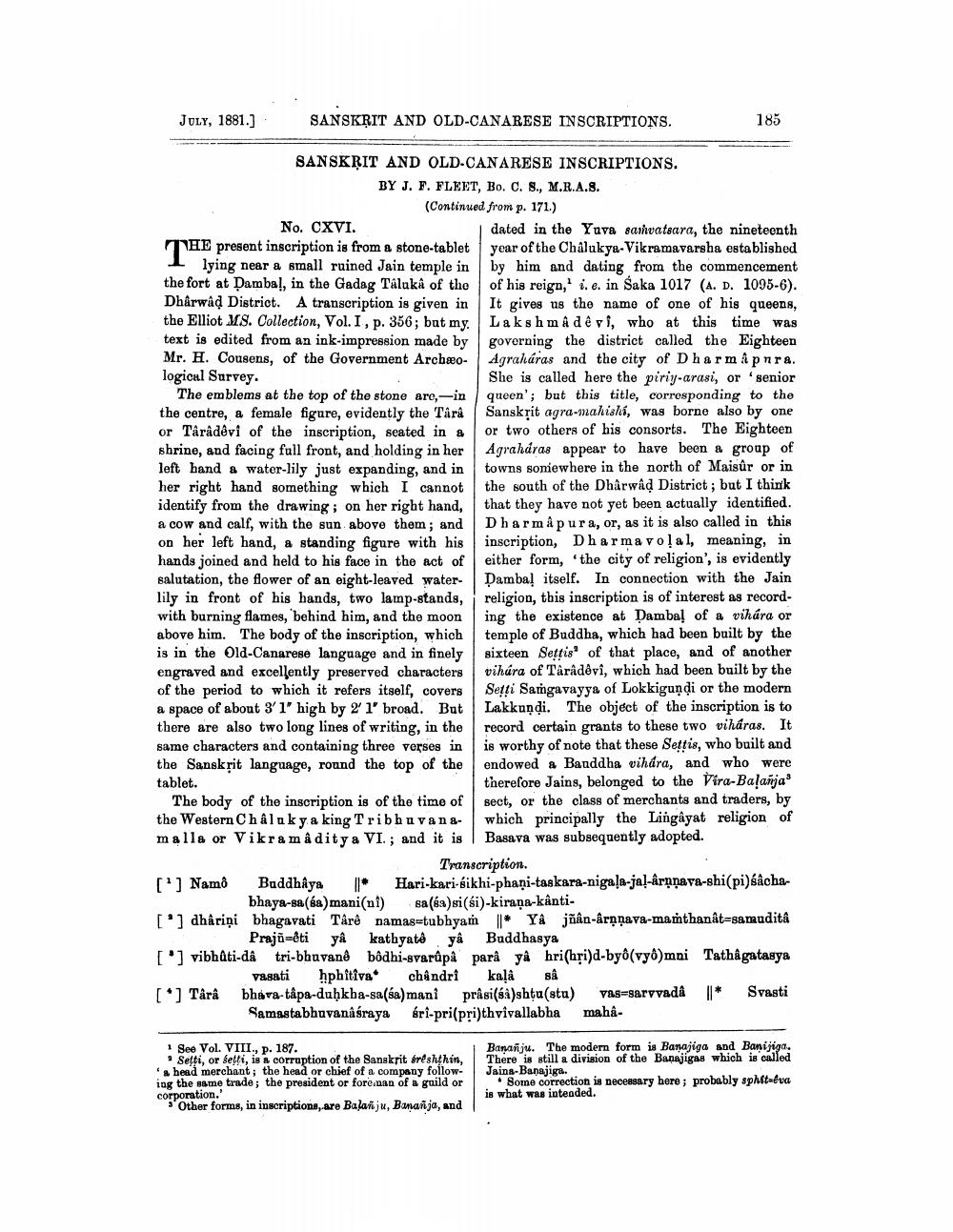________________
July, 1881.]
SANSKRIT AND OLD-CANARESE INSCRIPTIONS.
185
SANSKRIT AND OLD-CANARESE INSCRIPTIONS.
BY J. F. FLEET, Bo. C. 8., M.R.A.S.
(Continued from p. 171.) No. CXVI.
|dated in the Yuva sarvatsara, the nineteenth THE present inscription is from a stone-tablet year of the Chalukya-Vikramavarsha established
1 lying near a small ruined Jain temple in by him and dating from the commencement the fort at Dambal, in the Gadag Taluka of the of his reign,' i.e. in Saka 1017 (A. D. 1095-6). Dharwad District. A transcription is given in It gives us the name of one of his queens, the Elliot MS. Collection, Vol. I, p. 356; but my Lakshmå de vi, who at this time was text is edited from an ink-impression made by governing the district called the Eighteen Mr. H. Cousens, of the Government Archæo- Agraháras and the city of Dharm Åpnra. logical Survey.
She is called here the piriy-arasi, or senior The emblems at the top of the stone are,-in queen'; but this title, corresponding to the the centre, a female figure, evidently the Tárå Sanskrit agra-mahishi, was borne also by one or Târâdêvi of the inscription, seated in a or two others of his consorts. The Eighteen shrine, and facing full front, and holding in her Agrahdras appear to have been a group of left hand & water-lily just expanding, and in towns somewhere in the north of Maisûr or in her right hand something which I cannot the south of the Dharwad District; but I think identify from the drawing; on her right hand, that they have not yet been actually identified. a cow and calf, with the sun above them; and Dharmapura, or, as it is also called in this on her left hand, a standing figure with his inscription, Dharma volal, meaning, in hands joined and held to his face in the act of either form, 'the city of religion', is evidently salutation, the flower of an eight-leaved water- Dambal itself. In connection with the Jain lily in front of his hands, two lamp-stands, religion, this inscription is of interest as recordwith burning flames, behind him, and the moon ing the existence at Dambal of a vihára or above him. The body of the inscription, which temple of Buddha, which had been built by the is in the Old-Canarese language and in finely sixteen Settis' of that place, and of another engraved and excellently preserved characters vihára of Târâdêvî, which had been built by the of the period to which it refers itself, covers Setti Sangavayya of Lokkigundi or the modern a space of about 3' 1' high by 2' 1' broad. But Lakkundi. The object of the inscription is to there are also two long lines of writing, in the record certain grants to these two viharas. It same characters and containing three verses in is worthy of note that these Settis, who built and the Sanskrit language, round the top of the endowed a Bauddha vihdra, and who were tablet.
therefore Jains, belonged to the Pira-Balañja The body of the inscription is of the time of Bect, or the class of merchants and traders, by the Western Châluky a king Tribhuvane- which principally the Lingayat religion of malla or Vikramaditya VI.; and it is Basava was subsequently adopted.
Transcription. [] Namo Buddhaya | Hari-kari-Sikhi-phani-taskara-nigala-ja!-årņņava-shi(pi)śâcha
bhaya-sa (sa)mani(nl) sa (sa)si(si)-kiraņa-kânti['] dhåriņi bhagavati Târê namasutubhyan ll* YA joan-ârņņava-mamthanat=samudita
Prajă-êti ya kathyatê ya Buddhasya ['] vibhati-dâ tri-bhuvanê bôdhi-svarûpå parå yå hri(hri)d-byő(vy)mni Tathagatasya
Vasati hphitiva chandrikala så [] Târâ bhava-tâpa-duḥkba-sa(sa)mani pråsi(á)shtu(sta) Vas=sarvvada ||* Svasti
Samastabhavanasraya sri-pri(pri)thvivallabha mahd
1 See Vol. VIII., p. 187. • Setti, or sell, is corruption of the Sanskrit Sreshthin, a head merchant; the head or chief of a company following the same trade; the president or forean of a guild or
Other forms, in inscriptions are Balañju, Banasija, and
Bamañju. The modern form is Banajiga and Banijiga. There is still a division of the Banajigas which is called Jaina-Banajiga.
• Some correction is necessary here; probably sphitelva is what was intended.
corpore some chant




